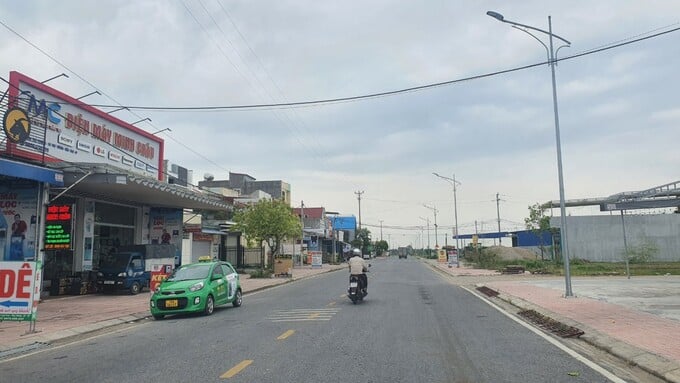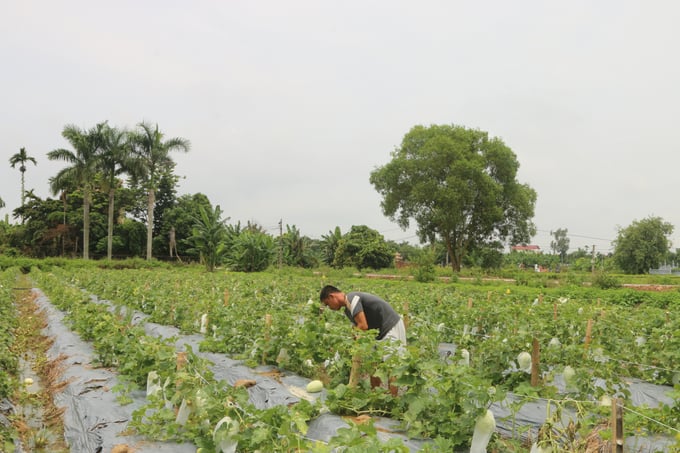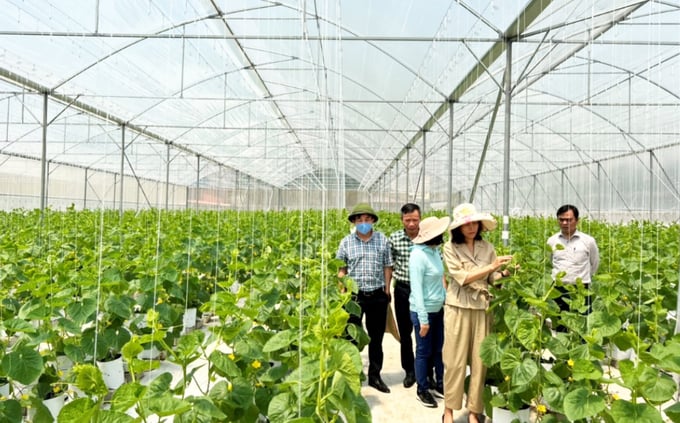May 22, 2025 | 14:43 GMT +7
May 22, 2025 | 14:43 GMT +7
Hotline: 0913.378.918
May 22, 2025 | 14:43 GMT +7
Hotline: 0913.378.918

The new model countryside road in Thuy Huong commune, Kien Thuy district. Photo: Dinh Tung.
With the aim of improving rural residents’ livelihoods in line with new rural construction, the Resolution of the Hai Phong People's Council also sets the orientation for agroproduction development, which is "Building model new countryside associated with effective implementation of agricultural restructuring and rural economic development - improving rural people’s life both physically and mentally". Localities are making great efforts to carry out this policy.
People in Kien Thiet commune, Tien Lang district used to grow only two rice crops a year, earning meager income, so life was difficult all year round. Later some households received training on the rice – melon and rice – chili intercropping model from Hai Phong Agricultural Extension Center. Realizing that farmers grew muskmelon, honeydew melon, and chili effectively on the ground of just-harvested rice crops, the households boldly followed this method.
Melons can be harvested after 55-60 days counting from the sowing date, helping farmers earn VND 110-150 million/crop on average. Having experienced the model's effectiveness, now farmers in Kien Thiet commune are switching to growing honeydew melon. Many families have achieved great success thanks to applying the two rice crops – one melon crop.

People have switched from rice farming to effective melon growing models. Photo: Dinh Tung.
Meanwhile, new rural construction in Kenh Giang commune, Thuy Nguyen district is taking place with great enthusiasm. The restructuring of crops is also directed very clearly.
Implementing criterion 13.3 in new rural construction, Song Gia Investment & Development Cooperative has implemented a hi-tech melon growing model in A2 Trai Kenh village (Kenh Giang commune) with a scale of 6,800 m2, in which 3,300 m2 of land is utilized to plan muskmelon and Bach Ngoc honeydew melon according to organic farming methods.The cooperative’s hi-tech agroproduction model applies a standard procedure that is strictly controlled from seed selection, growth monitoring, watering until the melons are harvested.
"Growing melons in polyhouse has many advantages in terms of crop management. The polyhouses help to cover rain and prevent insects from entering, reducing the overall production costs due to less use of pesticides. In the near future the cooperative will continue to organize safe production in order to meet VietGAP and organic standards. The production process will associate with branding, traceability, and production linkages and product underwriting between farmers and businesses. Our goal is to increase income and value of agroproduction in the area," said Nguyen Thi Thuy Ha, director of Song Gia Cooperative.

Hai Phong Agricultural Extension Center always accompanies people on the path of developing crop restructuring models. Photo: Ha My.
Hai Phong has set a goal that by 2025 there will be 137 communes that meet the standards stated in the Criteria for Model Rural Communes and complete the criteria for advanced new rural areas according to the Central Government’s regulations. When this goal is completed, at least 70% of the main roads in communes from the district roads to the commune center and inter-commune roads will be paved with asphalt at least 9m wide, have sidewalks or curbs, drainage ditches and electricity for residential lighting.
In parallel with building new rural areas, Hai Phong's agricultural sector will continue to promote agricultural restructuring and economic restructuring in the direction of developing concentrated, large-scale commodity agroproduction along the value chain. The development of agroproduction will proceed in line with tourism and new rural construction. Advanced technology, high technology, mechanization will be fully utilized to improve added value, productivity, quality and competitiveness of products in domestic and export markets.
On the other hand, Hai Phong will accelerate the implementation of land accumulation and concentration policies for large-scale agricultural development, convert inefficient rice land to produce agro-products of high economic value, and build raw materials areas to supply agro-products for processing and hi-tech agricultural zones.
Hai Phong strives to achieve a number of goals by 2025: GRDP growth in agriculture, forestry and fishery reaches 2.0%/year; production value growth reaches 1.7%/year; the structure of agriculture - forestry - fishery production value is 55.90% - 0.20% - 43.90%; the added value per unit of agricultural land is VND 180 million/ha (current price); the value of crop production reach VND 245 million/ha; the rate of crop production area applying advanced and high technologies reach 62.4%.
Translated by Samuel Pham
![Reducing emissions from rice fields: [2] Farmers’ commitment to the soil](https://t.ex-cdn.com/nongnghiepmoitruong.vn/608w/files/news/2025/05/05/dsc08881jpg-nongnghiep-140632.jpg)
(VAN) Clean rice cultivation model in Thuong Tan commune, Bac Tan Uyen district, is assisting local residents in achieving sustainable agriculture by substantially reducing costs, increasing productivity, and protecting the environment.

(VAN) At the conference to disseminate Resolution No. 68, AgriS introduced its digital agricultural ecosystem and reaffirmed its commitment to accompanying the Government in promoting private sector development and sustainable agriculture.

(VAN) 'Blue Ocean - Blue Foods' initiative is designed to restore marine ecosystems and establish sustainable livelihoods for local communities by cultivating a minimum of 1,000 hectares of cottonii seaweed in the first three years.
/2025/05/21/4642-3-112707_603.jpg)
(VAN) The V-SCOPE project has made direct contributions to three out of six pillars of the Comprehensive Strategic Partnership between Vietnam and Australia.

(VAN) Facing the threat of rabies spreading to the community, Gia Lai province urgently carries out measures to vaccinate dogs and cats on a large scale.

(VAN) Disease-free livestock farming not only protects livestock herds but also stabilizes production and livelihoods for many farmers in Tuyen Quang.

(VAN) Japan's grant aid project contributes to capacity building, promoting organic agricultural production, and fostering sustainable community development in Dong Thap province.